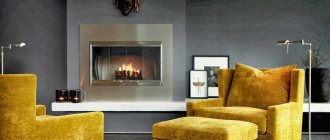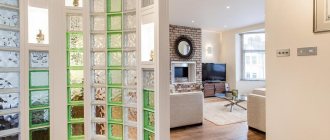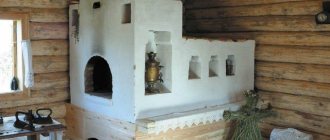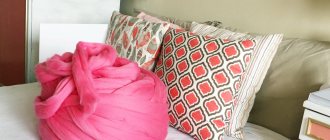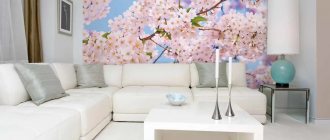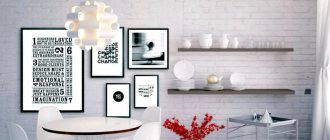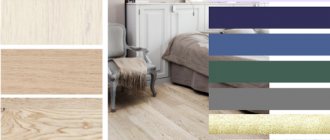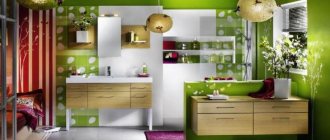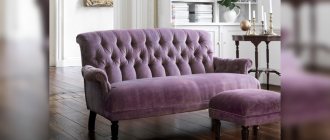Where are glass blocks used?
Glass blocks are distinguished by good sound-proofing and heat-saving properties, increased resistance to moisture and other external factors.
Application of material:
- For finishing walls or creating decorative inserts.
Decorative insert made of glass blocks Source homester.com.ua
- To create partitions and divide a room into functional zones.
- For finishing external walls of residential premises.
Glass blocks in a modern interior Source evrookna-mos.ru
- For zoning bathrooms, finishing shower walls.
The variety of surfaces, shapes and colors of glass blocks allows this material to be used for finishing rooms in various stylistic directions.
Most often, glass blocks are used to decorate the bathroom. The material is practical, resistant to high humidity, easy to care for, more reliable and durable compared to plasterboard.
Glass blocks in the bathroom Source pinterest.com
Walls made of glass blocks are suitable for decorating a shower stall.
In combined bathrooms, you can use material to divide a spacious room into functional zones. A straight or rounded wall made of multi-colored or single-color glass blocks can be used to decorate a shower stall or drain. You can also make a small partition between the toilet and the bathroom.
In a large room, you can separate the washing machine from the main area, creating a small room for washing and storing linen.
In the bathroom of a country house, you can cover the window with glass blocks with colored designs or stained glass; when exposed to sunlight, the window looks interesting and unusual.
Partitions and walls made of glass blocks are highly durable, but cannot replace load-bearing walls.
See also: Catalog of companies that specialize in interior redevelopment.
Area of application: bathroom
Glass blocks get along well with the urban styles of high-tech, loft, contemporary, minimalism and some variants of classics and baroque. In doses, you can introduce glass brick into a Scandinavian interior with a cold color scheme, but in “warm” eco-style and Provence, glass will most likely look alien.
There are several common ways to use glass blocks when decorating a bathroom. Each option can be used individually or in combination with others.
Walls
A wall made of glass blocks is a current solution for dark rooms. In this way, you can effectively decorate a divided bathroom and reduce energy costs. Replacing at least one blank wall or part of it with glass blocks will visually expand the space and improve illumination (due to the penetration of sunlight or artificial light from neighboring rooms).
In a small bathroom, it is better to build a glass wall from elements of the same shape and color. The color can repeat the main shade of the interior or create a bright contrast with it, but overall the wall should look uniform. Too colorful designs focus attention on the size of a small room. In large spaces there are no such restrictions; it is only advisable to take into account the general color palette.
Partitions
Glass blocks are an ideal solution for constructing partitions: the transparent or translucent structure of the material does not “eat up” the space, but does an excellent job of functional zoning. Partitions made of glass blocks are especially appropriate in a combined type bathroom. Glass blocks are laid in continuous rows or combined with other materials (brick, drywall). The side part of the partition can be designed flat, figured or stepped.
Window
Glass block windows are a fashionable and cost-effective choice. The design will cost much less than double-glazed windows, but will provide the necessary tightness. Glass blocks can be used to decorate only the perimeter of the window opening, but the option of filling the entire window is more practical and is used more often. The level of transparency of a glass block window is determined at the planning stage, taking into account the height of the opening above the floor level and the amount of natural light entering. It is advisable to make low-lying windows as opaque as possible.
Shower cabin
Very often glass blocks separate the shower area. Such fencing is more reliable than fragile solid glass partitions and more aesthetically pleasing than conventional curtains. Glass blocks can be used to make all the shower walls. Such designs look impressive, especially with the mutual reflection of the walls of the shower stall and the refraction of falling water drops. Rounded glass block railings are especially original and look most organic in the shower area.
In the living room
Glass blocks in the living room interior can be used to create full-fledged partitions.
Glass blocks in the bedroom interior Source remontbp.com
The use of glass elements in wall decor looks very interesting, stylish and unusual.
Decorating walls with glass blocks Source HappyModern.RU
The material is used to construct the base of a small coffee table or a full-fledged dining table.
Glass blocks in the living room Source remontbp.com
By decorating the walls with glass blocks, you can highlight the necessary area in the room.
Glass blocks in the interior of an apartment (60 photos)
Today we propose to open an old chest that smells of mothballs and pull out of it... You won’t believe it! Glass blocks!
Yes, those same squares of massive glass that were familiar to every citizen of the USSR from the interiors of bathhouses, hospitals or staircases. Now they have been transformed, decorated, relevant and occupy their own, quite nice, niche in the design of modern interiors.
What is glass block?
A traditional glass block was a hollow cube with walls made of glass about one centimeter thick, which, due to the internal air cushion, reduced sound transmission by 60–70%, light transmission was 80%, and dense glass blurred the outlines of people behind it and prevented anyone from watching. which was not intended for prying eyes. In addition, they were very durable, so glass walls made of cubes did not frighten either mothers in kindergartens or residents of Brezhnevkas, whose entrances were regularly decorated with blue-green glass delights.
Old glass blocks
But as the wise Ovid said: “Tempora mutantur, et nos mutamur in illis” (translation: Times change, and we change with them), so the glass blocks have changed, acquiring new forms - for example, bricks; new content - they are filled with installations, herbariums or mother of pearl; a new type is decoration with ornaments or graphics, as well as painting glass in different colors. The sizes of glass blocks in apartment interiors vary greatly, but the most popular are standard cubes 24x24x8 and 19x19x8.
Modern glass blocks
Advantages of interior design using glass blocks
Well, firstly, those still Soviet advantages have not gone away, such as:
- strength of glass block structures;
- good light transmission;
- increased sound insulation;
- protection from immodest glances.
Shower cabin made of glass blocks
However, with the improvement of construction technologies, additional arguments have emerged for decorating the interiors of modern apartments using glass blocks:
- increased moisture resistance, which makes it possible to use glass blocks in showers, bathrooms, swimming pools, saunas;
- greater resistance to physical influences and aggressive temperatures;
- excellent thermal insulation;
- unlimited number of cleanings with any detergents;
- stylish appearance.
The last point is why glass blocks can now be seen in kitchens, living rooms, hallways and even bedrooms, because with their help the most run-down Khrushchev building can be turned into the palace of the Snow Queen.
Column made of glass blocks in the art deco hall
Where are glass blocks used?
Well, the reviews about glass blocks in the interior of an apartment are such that their use is limited only by the flight of your imagination, and the properties of glass cubes are so amazing that they can even withstand the stress of walking or dancing. And light transmission allows them to be effectively illuminated from the inside - look at the photo: in front of you is a floor made of matte blue glass blocks with LED lighting along the baseboard.
Glass blocks on the floor
Windows and working walls in the kitchen, interior openings and staircases, shower cabins and partitions, decorative accessories and household items, columns made of glass blocks and windows made of them in plasterboard walls - the possibilities of glass cubes are very extensive, but what is suitable for modern urban interiors , will look out of place in classic rooms. More on this below.
Interiors in which the use of glass blocks is acceptable
If you are fans of the so-called museum styles: Empire, classicism, gothic, baroque or renaissance, then it is better to forget about glass blocks - they are incompatible, but for more laconic interiors they will be just a godsend. Take a closer look at glass cubes and bricks if you like:
- constructivism;
- pop Art;
- eclecticism;
- minimalism;
- urbanism;
- eco-style;
- postmodernism;
- high tech;
- in some cases - fusions of country, modern, art deco.
Glass block walls in an eclectic bathroom
Rules for interior design using glass blocks
Everything is good in moderation, including glass blocks. Glass cubes can bring icy chic and translucent beauty to the environment, but don't go overboard with glass unless your goal is to create a cold cave.
Glass block inserts in the hallway and staircase
1. The maximum proportional ratio of glass blocks to other finishing materials in living rooms is 1:10, in bathrooms and toilet rooms - unlimited. 2. Try to combine the icy coldness of glass with “warm” finishing materials: wood, forging, laminate, wallpaper, fabrics. 3. When using colorless transparent glass blocks, try to balance the color scheme with other, brighter tones - who would like a hospital room in an apartment instead of a living room? 4. Glass blocks successfully zone space: they can be used, for example, to separate the kitchen from the recreation area in a studio apartment, but do not forget that in living rooms glass cubes should carry a decorative, not a functional load.
Decorative wall with glass block inserts
5. Memo to fans of construction kits:
There are specialists who are able to create real masterpieces of furniture art from glass blocks, but it is important to understand that a table made from glass blocks cannot be moved to another place. For safety and stability reasons, such furniture is formed on rigid, fixed frames and, although it will look very stylish, it will not be possible to move it.
Glass block table in the kitchen
You see what a treasure we found in the depths of an old chest... Who would have thought that ordinary glass blocks could add such a zest to the design of modern apartments. We hope that our advice and numerous real photos will help you decide on your wishes, one of which will definitely be a small elegant wall made of glass blocks in the interior of the apartment.
Small pool made of glass blocks
Examples of interior design using glass blocks
Glass blocks in the interior of the hallway
Large floor frosted glass blocks
Glass block wall in the kitchen-dining room
Inserts made of colored glass blocks in a plasterboard wall
Hallway wall decorated with glass block inserts
Interior wall made of glass blocks in the bedroom
Interior opening made of glass blocks in the hallway interior
Dividing wall made of colored glass blocks in a combined bathroom
Decorative wall made of glass blocks in a modern interior
Bar counter made of glass blocks illuminated from within
Decorative window made of colored glass blocks in the recreation area
Interior wall made of glass blocks in the kitchen interior
Shower cabin made of glass blocks
Table made of two-color glass blocks
Glass block inserts on the accent wall of the living room
Figured interior wall made of glass blocks in the office
Dining table with glass block frame
Window and decorative wall made of glass blocks in the bedroom interior
Insert of colored glass blocks in brickwork
Decorative inserts made of colored glass blocks in the bathroom
Inserts made of bright glass blocks in pop art interiors
Elegant window made of glass blocks in the interior of the bathroom
Working wall and window made of glass blocks in the kitchen interior
Wall made of glass blocks in a combined bathroom
Decorative columns with glass block inserts
Glass block window in the interior of the dining room
Figured zoning wall made of glass blocks
Working wall made of glass blocks in the kitchen interior
Interior glass wall
Walls and floor elements made of glass blocks in the kitchen interior
Glass block windows in the bathroom interior
Film stained glass on a glass block window
Figured dividing wall made of glass blocks in the interior of a studio apartment
Window made of mosaic glass blocks
Glass blocks in the bathroom interior
Zoning bay window made of glass blocks in a studio apartment
Wall of two-tone glass bricks in the bathroom
Decorative interior opening made of colored glass blocks
Decorative elements made of glass blocks in the kitchen interior
Bathroom: windows made of two-tone glass blocks
Figured glass blocks in a metal frame
Glass blocks in the interior of a modern kitchen
“Bay window” wall made of glass blocks in the living room interior
Glass blocks with interior decor on the floor in the dining room
Shower and toilet cubicles made of glass blocks in the interior of a combined bathroom
Tall glass block windows in the living room interior
Interior wall with an ornament made of opaque colored glass blocks
Glass blocks from the Italian collection
Glass blocks in a harlequin bathroom with visual effects
In the bedroom
Glass blocks in the bedroom interior create a calming and relaxing atmosphere due to their ability to diffuse and refract light.
A glass block partition will help create a cozy atmosphere in the sleeping area.
Glass blocks can be used to decorate a doorway or part of a wall.
Decorating a bedroom with glass blocks Source remoo.ru
A wall made of blocks located opposite the window will create a festive atmosphere in the room, especially if you choose colored glass blocks, such as green ones, for decoration.
Green glass blocks in the bedroom Source happymodern.ru
In the hall
In most cases, hallways have a small area; to visually enlarge the space, you can use light shades in the interior or decorate the corridor with glass blocks.
The door to the living room can be replaced with a beautiful arch made of glass blocks.
The floor and ceiling can also be finished with a strong material, such as blue. You can make a small table from glass blocks near the wall.
Floor and ceiling made of glass blocks Source lboz.ru
Adding glass blocks to your wall trim can help improve illumination in a poorly lit hallway.
Wall decoration with glass blocks Source roomester.ru
In the kitchen
Glass blocks are used more often in creating kitchen interiors. Glass material is used not only for finishing walls, window and door openings, but also for finishing a kitchen apron, decorating and zoning a room.
Wall decoration with glass blocks Source roomester.ru
Recently, glass blocks have been used to make table bases. This decor looks quite interesting and unusual.
Clear glass blocks pair well with white kitchen cabinetry or wood trim.
Wall decoration with glass blocks Source homester.com.ua
What types of glass blocks are there?
With increasing demand for the material, manufacturers began to introduce new shapes, colors and textures of glass blocks. Square and rectangular shapes are more popular compared to round and triangular ones. Strong and durable material can also be in the form of diamond, wave, hexagon.
Colored glass blocks in the interior Source topdom.ru
Depending on the scope of use, they distinguish: construction and decorative glass blocks.
Glass blocks made in Germany and Italy are considered the most expensive and high quality. They are distinguished by their strict shapes and sizes, a wide palette of shades, and a well-polished surface.
Manufacturers from the Czech Republic make bright glass blocks by painting them from the inside. This method makes it possible to reduce the cost of production while maintaining the quality properties of the product.
The budget option includes materials produced in Russia and Poland. Manufacturers are expanding their range with a variety of shades and textures of blocks.
The lower price segment is occupied by glass blocks from Belarus and China.
Depending on the material from which glass blocks are made, there are:
- plastic - glass blocks inside special structures;
- glass blocks made of cellular glass.
Manufacturers make 2 main types of glass blocks: transparent and colored. When producing colored glass blocks, dyes are added to the mass before molding.
Depending on the surface, there are 4 types of glass blocks:
- Sanded, smooth, throughput is 85%.
- Matte, transmits 50% of light.
- Glossy, obtained by polishing.
- Embossed, can diffuse or direct light.
- Glass blocks with a pattern or pattern have a high cost due to the complexity of production.
- Glass blocks with inserts are usually created for a specific design project.
Interior design with glass blocks Source roomester.ru
Depending on the lighting qualities, the material is divided into: light-directing, light-diffusing and translucent glass blocks.
It is necessary to choose glass blocks for the interior design of a living space based on the chosen stylistic direction and color design.
Glass blocks for partitions
A glass block is a block of thick glass plates fused into a single structure. A sealed air cavity is formed inside such a block, which increases sound and heat insulation parameters.
In other words, a glass block is a kind of glass brick of various shapes, from which you can lay various building and interior elements.
Advantages
Due to its structure, glass block has the following advantages:
- Natural materials in the composition ensure environmental friendliness.
- Unique properties: high mechanical strength (including compression and impact) and wear resistance, resistance to low and high temperatures, as well as temperature changes.
- Increased heat and sound insulation properties, not inferior to hollow bricks.
- Fire safety ensured by the non-flammability of the material.
- Ease of installation and further maintenance. The blocks can be cleaned with any detergent.
- Absolute moisture-proofness and water resistance, which makes it possible to use it as outdoor elements and in rooms with high humidity, even in water.
- Decorative. The glass block surface does not require additional finishing coatings. Modern blocks have different colors and shapes, which makes it possible to create the desired, attractive design.
An important distinctive feature of glass blocks is the ability to transmit diffused sunlight and provide unique lighting for the room . At the same time, the opacity of the elements protects from prying eyes.
Flaws
Like any building material, glass blocks also have certain disadvantages that must be taken into account during construction:
- The large weight significantly burdens the entire building structure. Taking into account this property, it is undesirable to erect walls and partitions with an area of more than 16 m².
- Increased cost of decorative glass blocks, which can reach 1500-1700 rubles/piece. At the same time, you can use ordinary economy class blocks with a cost of 100-130 rubles/piece.
- Problems that arise when attaching shelves and attaching various objects, because... It is difficult to secure a screw or nail in glass blocks. They can be solved using other standard fasteners and suction cups.
In general, glass blocks continue to be unfairly considered an exotic material. This attitude is developed due to a mistrust of the strength of glass. However, a glass block is quite difficult to destroy even with hammer blows, and their use is perhaps limited only by their increased cost.
What types of glass blocks are there?
Modern glass blocks do not have a legal classification, but the following main criteria for distribution by type can be distinguished:
- Block size. The most common are square-shaped glass blocks measuring 19x19 and 24x24 cm with a thickness of 8-10 cm, as well as rectangular elements measuring 19x9x8 and 24x11.5x8 cm. The weight of the bricks depends on the size and is in the range of 3-4.5 kg.
- Form. In addition to the most common square and rectangular options, glass blocks are available in triangular, round, and also in the form of a hexagon and the letter “G”. Elements can have clear, straight or rounded corners.
- Color palette and interior filling. The color of glass blocks can be different - from unpainted glass to bright shades (red, blue, black, etc.). There is usually an air cavity inside, but some models use decorative elements that are melted inside the block and create a specific pattern.
- Surface structure. Elements can have a smooth, glossy, corrugated, patterned surface. In addition, products with a matte surface are produced. The light transmission of the material depends on the structure.
- Glass element thickness . This indicator is responsible for the strength, specific gravity and some other characteristics of the material. Most often, blocks are made of glass with a thickness of 5.5-7 mm.
- Mechanical strength. Standard elements have fairly high strength, but additionally high-strength glass blocks are offered that can withstand even a bullet from a gun.
- Optical parameters . Products with this characteristic have a wide range - from almost transparent to opaque options. Glass blocks can provide directional or diffuse light output.
We recommend: Types of drywall, characteristics, rules and options for self-installation on walls
. Finally, glass blocks are distributed according to their intended purpose . The following main categories are distinguished: decorative, interior and building blocks. They differ in appearance, size, color, strength and other parameters.
We recommend reading: Properties, types and production technology of building glass
Features of interior glass blocks
The material is resistant to moisture, high or low temperatures, and easily transmits light, allowing you to save energy. It is not difficult to maintain glass blocks in their original form: they are easily cleaned of dirt with a damp cloth. Glass blocks in the bathroom interior allow you to increase the space of the room due to the ability of the material to transmit light.
Interior design with glass blocks Source remontbp.com
But there are negative sides to using them. You cannot attach a shelf or any decoration to a glass block wall or partition. They cannot be cut, it is impossible to lay electrical wiring between them.
Wall decoration with glass blocks Source peregorodkainfo.ru
Glass block partitions cannot serve as a load-bearing wall.
Glass blocks in the interior Source roomester.ru
If you cover a window with glass blocks, the ability to ventilate the room will disappear. Double-glazed windows made from glass blocks will help cope with this problem.
Glass block finishing Source dekormyhome.ru
Installation of glass block partitions
Creating structures from glass blocks is a simple process. Installation of glass block partitions includes the following steps:
- Determining the installation location of the partition.
- Preparing and cleaning the mounting surface. Using slats, you need to outline the boundaries of the base of the structure.
- Laying the first row of glass blocks.
- Installation of stainless steel reinforcing rod. It is not recommended to lay more than 3 rows of blocks per day, as the structure may warp.
- After the mixture has completely dried, you need to remove the crosses and protective film on the blocks and begin applying the grout mixture.
- After cleaning the partition and drying it completely, it is necessary to protect the structure from moisture by applying a waterproofing liquid.
Glass blocks in a modern interior Source www.gradnja.rs
Useful qualities of glass blocks
They are a block that consists of glass plates welded together with a thickness of at least 100 mm. There are different types and sizes of glass blocks. They most often represent an equilateral square, but they also come in triangular and round shapes. Standard sizes are 19x19 and 24x24 cm. The weight of an individual block ranges from 2 to 4 kg.
Physical properties:
- Transparency;
- Sound and heat insulation;
- Non-flammability;
- Strength;
Glass does not react with the external environment, due to this, oxide films do not form on it, and it is easy to clean.
